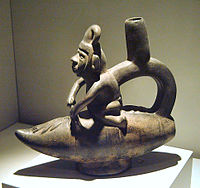
Back الكاباليتو Arabic Caballito de Totora German Caballito de totora Spanish Caballito de totora French Caballito de totora GL Caballito de totora Portuguese Totora Swedish Кабаліто-де-тотора Ukrainian


Caballitos de totora are reed watercraft used by fishermen in Peru for the past 3000 years, archaeologically evidenced from pottery shards. Named for the way they are ridden, straddled ('little reed horses' in English), fishermen use them to transport their nets and collect fish in their inner cavity. The name is not the original name, as horses were not introduced to South America until after the Spanish conquest of the Inca Empire. The ancient Mochica name of the watercraft is tūp. They are made from the same reed, the totora (Schoenoplectus californicus subsp. tatora), used by the Uru people on Lake Titicaca, and considered part of the Peruvian's National Cultural Heritage since 2016.[1]
- ^ "Totora reed declared cultural heritage in Peru". Andina. Archived from the original on 2020-07-27.